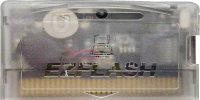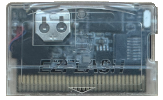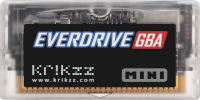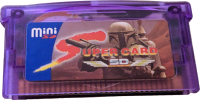A Quick Guide on GBA Flashcarts
Here are the best GBA flashcarts available on the market currently. For other consoles, please see the quick start guide list.
The below flashcarts are purchasable from AliExpress or reputable retro accessory stores like Hand Held Legend and Retro Game Repair Shop.
Recommended carts #
EZ Flash Omega Definitive Edition #
 Premium option with the best battery life as of revision B. It has some niche features like rumble and Slot-2 DS compatibility for linking. Fixes save issue from regular version. Has a bigger pcb so it doesn’t come with the alternative DS Lite shell that the EZ Flash Omega included. Mahko made a more indepth post here.
Premium option with the best battery life as of revision B. It has some niche features like rumble and Slot-2 DS compatibility for linking. Fixes save issue from regular version. Has a bigger pcb so it doesn’t come with the alternative DS Lite shell that the EZ Flash Omega included. Mahko made a more indepth post here.
The EZ Flash Omega DE uses a CR1025 battery for it’s real-time clock (RTC). The battery itself is not save-critical as the cart uses FRAM instead of SRAM for storing save data. The battery is held in with a battery contact clip, therefore no soldering is required to replace the battery. There isn’t any warning to say that the battery is running dry. The only sign that your battery needs replacing is that the RTC resets itself to the default time on each boot.
Purchase Links #
This cart costs around $90 USD. Purchase links have been provided here though they may not be the cheapest listings out there:
- Zedlabz: https://www.zedlabz.com/products/ez-flash-omega-definitive-edition-cartridge-for-game-boy-advance-sp-ez-flash
- Retro Game Repair Shop: https://retrogamerepairshop.com/products/ez-flash-omega-definitive-edition
- Senkogames: https://senkogames.com/products/ez-flash-omega-definitive-edition-gameboy
EZ Flash Air #
 The EZ Flash Air is a budget flashcart which intends to replace the EZ Flash Omega. It is not a successor to the EZ Flash Omega DE, but they do share a similar design and shells can be interchanged between the two. The Air comes with a transparent shell, and there is the option to buy official red, green and blue shells too. It does not have the option of a DS Lite shell as the PCB is too big.
The EZ Flash Air is a budget flashcart which intends to replace the EZ Flash Omega. It is not a successor to the EZ Flash Omega DE, but they do share a similar design and shells can be interchanged between the two. The Air comes with a transparent shell, and there is the option to buy official red, green and blue shells too. It does not have the option of a DS Lite shell as the PCB is too big.
The Air uses SRAM for saves, which means the battery is save-critical. If the battery dies, the save file from the current game will be lost upon reboot, This is in contrast to the Omega, which was able to write save files directly to the SD card without needing a battery. Fortunately, the battery in the Air is easy to replace. It is a CR1220 battery held in with a clip, rather than being soldered in place like the Omega.
PSRAM was dropped from the EZ Flash Air in favour of a 960Mbit (120MB) NOR flash, up from the 512Mbit in the Omega/DE. Because of this, games must be written to the NOR flash before they can be played. The small size of the NOR flash will also limit the number of games you can store in it at one time. Write speeds to the NOR flash are quite slow, with it taking roughly 2 minutes to write 256Mbits (32MB). When deleting games from the NOR flash, you can only remove them in the reverse order of which they were written. For example, if you have four games stored in the NOR flash and want to delete the second game, you must also delete the two other games written after it.
RTC, cheats and soft-reset are all supported on the Air, but you lose out on save states and sleep mode which were present on the Omega. Some extra features the Air brings include GBA/DS Rumble support and DS-GBA link support, it does not have RAM expansion. There is a switch on the side to swap between Mode A and Mode B (DS Rumble pak or Link mode). When mode B is set to Link mode, the Air will load the first game written to the NOR flash as a standalone GBA game. This is inconvenient as to change the game used in link mode, you must remove all of the games stored in the NOR flash first before rewriting your chosen title.
Information about the Air and it’s issues is still quite limited, most of what is written here came from EZ Flash’s FAQ document and GBASP’s review on the cart. Both are worth a read if you are considering the Air. A lot of cost was cut to make the Air cheaper than the Omega and the DE, but this came at the sake of convenience.
Purchase Links #
This cart costs about $40-50 USD. Purchase links have been provided here though they may not be the cheapest listings out there:
- Zedlabz: https://www.zedlabz.com/products/ez-flash-air-cartridge-for-game-boy-advance-ez-flash
- Retro Game Repair Shop: https://retrogamerepairshop.com/products/ez-flash-air
- Senkogames: https://senkogames.com/products/ez-flash-air
Everdrive GBA Mini #
 Premium option from Krikzz. It fits snug like a regular cartridge. However, the EZ Flash Omega DE costs less and has more features in comparison. What it lacks in features, it gains in support and build quality. This may be a good option if you prefer better support over more functionality.
Premium option from Krikzz. It fits snug like a regular cartridge. However, the EZ Flash Omega DE costs less and has more features in comparison. What it lacks in features, it gains in support and build quality. This may be a good option if you prefer better support over more functionality.
The Everdrive GBA Mini uses SRAM instead of FRAM for storing save data, which means that the battery inside of it is save-critical. The cart should warn you when the battery is running dry. It uses a CR1220 battery which is held in with a battery contact clip - therefore no soldering is required to replace the battery.
Currently, this is the only GBA flashcart being sold by Krikzz. The previous Everdrive GBA X5 is no longer in stock.
Purchase Links #
This cart costs $99 USD. You can find it on Krikzz website here: https://krikzz.com/our-products/cartridges/everdrive-gba-mini.html
SuperCard SD #
 The cheapest budget option. While it offers the least amount of features, it has become an adequate option for those that need a GBA flashcart on a budget thanks to the hard work of custom firmware developers like David G.F. and MetroidManiac. The stock SuperCard firmware requires games to be manually patched with external software, and manual game saving via a menu. With CFW such as SuperFW or SCFW, games are automatically patched on-device, and game saving is taken care of automatically.
The cheapest budget option. While it offers the least amount of features, it has become an adequate option for those that need a GBA flashcart on a budget thanks to the hard work of custom firmware developers like David G.F. and MetroidManiac. The stock SuperCard firmware requires games to be manually patched with external software, and manual game saving via a menu. With CFW such as SuperFW or SCFW, games are automatically patched on-device, and game saving is taken care of automatically.
Note that to install a custom firmware on the SuperCard SD, you will need to either use a 2GB SD card first to launch the installer from the stock firmware, or a Slot-1 flashcart and a DSL/NDS system on hand.
The SuperCard SD is also a great option for those that need a cart to use in conjunction with TWiLight Menu++ on DSL/NDS systems to load GBA games natively from Slot-1.
An archive of the stock firmware and ROM patcher for this cart can be found here: https://archive.org/details/supercard-slot-2-series
The SuperCard SD does not work reliably on AGB-001 consoles. The reliability issues worsen if the console has a hardmod installed, such as an IPS display and/or a LiPo battery.
Alternative Custom Firmware #
As mentioned above, there have been efforts to improve this flashcart for normal use. There is a variety of custom firmwares that you can use on the SuperCard SD, each with their own features, pros, and cons. While they are all quite different to one another, they all support SDHC SD cards, which is a major improvement over the stock firmware.
SuperFW #
SuperFW has both a DS mode and a GBA mode. SuperFW can auto-save your games without having to reset to the main menu. It also automatically patches game ROMs while loading them, making SuperCard’s ROM patcher unnecessary. Unlike other CFWs mentioned below, it also has RTC patches for games that require a working RTC, and exFAT support. Do note, however, that it’s preferable to stick to FAT32, as it’s less likely to have issues in DS mode, and doesn’t corrupt as easily. SuperFW also has an in-game menu, which has options for updating the RTC clock in games, soft-resetting the game, resetting to firmware, manual saving, and save states management.
SCFW #
SCFW was the first of the three to be developed, and as of now, it only has a GBA mode. It automatically patches game ROMs, making SuperCard’s ROM patcher unnecessary. SCFW can also auto-save your games without having to reset to the menu. The modular kernel branch also features support for various GBA homebrew apps and emulators - you can find more details in this GBATemp thread.
SCSFW #
SCSFW mainly focuses on a DS mode for FlashMe/PassMe users. It does not have a GBA kernel, however, you can use it with SCFW or SuperFW if you need that functionality. It’s fairly limited in what it can do. It uses a custom build of nds-hb-menu which will let you run homebrew from the SD card. Since it is built into the firmware, you do not need any extra files on the SD card for it to work. SCSFW features automatic DLDI patching and boot hotkeys (press A+B on boot to configure them). The main use case for SCSFW is to autoboot into TWiLight Menu++.
Flashing firmware #
There are several ways to flash one of these firmwares to the SuperCard SD. Which one you use will depend on your setup and preferences:
- SCFW and SuperFW both have tools built in to flash SuperCard firmwares. All you need to do is follow the flashing instructions in their threads. If you are currently on the stock firmware of the cart, you will be limited to 2GB microSD cards during this process. However, once the new firmware has been flashed and is working properly, you can switch to an SDHC/SDXC card.
- If you have a DS flashcart that can run YSMenu, launching either SCFW or SuperFW from there with the SuperCard SD inserted should allow you to flash the firmware from there, bypassing the 2GB SD limit.
- SCKILL and superfw-nds-flasher-tool can be used from a DS flashcart to flash a new firmware as well as dumping your current one.
The SuperCard SDs being sold nowadays may use a flash chip with the id c2ba. These cannot be reflashed with the original updater/recovery tool from SuperCard. However, the flashing tools mentioned above all support writing to these carts without issue.
The SuperCard SD uses SRAM to store save data, so the battery is save-critical (depending on the firmware used). Most firmware options available for the SuperCard SD, including the stock firmware, have some sort of function to write your save file to the SD card without having to reboot your GBA. This means that, even if your battery is dead, you will still be able to keep your save data. The battery used in the SuperCard SD seems to vary in size depending on when you order one. They are held in with tabs soldered to the PCB, meaning that replacements are harder to find and install, especially if you haven’t soldered before. For replacement batteries, a CR1620 will fit just fine within the shell. A CR2025 is the biggest battery that can fit without any modification to the shell; however, it is a very tight fit and does cause the shell to warp slightly.
Purchase Links #
This cart costs anywhere between $10-20 USD. A purchase link has been provided but it may not be the cheapest listing out there:
- AliExpress [1]: https://www.aliexpress.com/item/1005005016129405.html
- AliExpress [2]: https://www.aliexpress.com/item/1005006706538645.html
- AliExpress [3]: https://www.aliexpress.com/item/1005009435346138.html
The SuperCard SD is also being sold under the “REMANK” name on Aliexpress. The “REMANK SuperCard” is the base SuperCard SD without any firmware modifications. The “REMANK FlashGBACart” is a SuperCard SD pre-flashed with SuperFW. If you were to buy the FlashGBACart variant, we cannot guarantee that it will have the latest SuperFW; it is advised that you check for updates before using the cart. If you are unable to find a 2GB MicroSD card or lack a Slot 1 flashcart to flash an alternative firmware, this is also an option.
Disclaimer #
The information contained in this post is based on discussions, pages and forums around the web. flashcarts.net, its members, moderators, and contributors do not claim to own any or all of these flashcarts; nor vouch they will never harm your system; nor guarantee any suggested price; nor warrant completeness of lists at any given point, nor speak on behalf-of any retailers, seller or vendor. In other words, use this for educational purposes and at your own risk.

This work is licensed under a Creative Commons Attribution-NonCommercial-ShareAlike 4.0 International License.